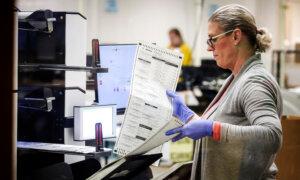Despite setting first-day records in several states, early voting patterns appear similar to those in recent elections cycles.
Nearly 70 percent of the more than 154.6 million Americans who voted in the 2020 election did so by “non-traditional means” with 43 percent voting by mail and 26 percent casting ballots in-person prior to Election Day in the 47 states that offer early voting,
according to the United State Census Bureau.
About 67 percent of Americans who were eligible to vote cast ballots in the 2020 election, a record overall turnout that saw a 73-percent boost in “nontraditional voting methods” from 2016, in most states discouraging in-person Election Day voting during the COVID-19 pandemic.
But even during the post-pandemic 2022 midterms, nearly 57 percent of the 112 million Americans who voted—a 46-percent turnout—did so by mail (36 percent) or during early voting (21 percent), according to a July 2023 Pew Research Center
analysis.As of Oct. 24, with 12 days remaining before 2024’s Nov. 5 election, it does not appear that mail-in voting will match those 2020 numbers and that early voting will be similar to the last few election cycles. However, the number of those choosing to cast ballots via “nontraditional voting methods” overall will exceed the
57.2 million who did so in 2016—according to the U.S. Election Assistance Commission—when 40 percent of the 139 million votes cast were by mail-in ballot or at early voting sites.
By Oct. 25, 2020, those 2016 “nontraditional voter” numbers had already been eclipsed. Nearly 60 million Americans had voted in-person early or via mail by then in advance of Election Day on Nov. 3, according to
an analysis by the University of Florida’s Election Lab.
As of 10 p.m. Oct. 24, 2024,
more than 31 million—slightly more than half who had done so at this point in pandemic-skewered 2020—had cast ballots via mail or in-person in the 36 states where early voting was underway, the Election Lab documents.
Twenty states, including battleground states Michigan, Wisconsin, and Georgia, do not register voters by party affiliation, so direct by-the-numbers 2000 and 2024 early voting and mail-in ballot comparisons can be difficult to divine.
The number of states in 2020 and 2024 Election Lab data sets, which only include states that registers voters by party affiliation, also vary.
Nevertheless, some patterns are evident.
Between the Election Lab’s 2020 numbers with nine days to go before the Nov. 3 election and its 2024 numbers with 12 days to go before the Nov. 5 election, there appears to be a significant drop-off in mail-in ballots being requested and returned, even in the
eight states where ballots are automatically mailed to voters.
Of 52.6 million mail-in ballots requested in 2020 from 18 states that register voters by party affiliation included in Election Lab’s
Oct. 25 survey, slightly more than 21 million had been returned. Democrats had more than a two-to-one advantage in these 18 states, 11 million to 5.1 million at this time in 2020.
Of 47 million mail-in ballots requested in 2024 from 25 states that register voters by party affiliation included in the Election Lab’s
Oct. 24 survey, nearly 11 million had been returned. Democrats had a 5 million to 3.6 million lead over Republicans with nearly 2.4 million returned by non-partisan voters as of late evening on Oct. 24.
Of 5.8 million Americans who had cast early ballots in the 2020 election by Oct. 25 in 10 states in the Election Lab survey, Republicans had a 2.3 million to 2.2 million advantage over Democrats at that time.
In 2024’s Oct. 24 Election Lab
survey of early in-person voting across 25 states that register voters by party affiliation, 4.4 million had voted. GOP voters led Democrats 1.8 million to 1.4 million with more than 1.2 million nonpartisans casting ballots as of late evening Oct. 24.
The numbers, although variable because different states are included in 2020 than in 2024, appear to confirm mail-in voting will be nowhere as prevalent this year as it was four years ago.
That conforms with a
Sept. 30 to Oct. 6 survey of 4,025 registered voters by Pew Research Center in which 52 percent of respondents said they plan to cast ballots by “nontraditional voting methods” with 28 percent saying they will do so by mail, 24 percent in-person during early voting, and 38 percent planning to vote on Election Day.


